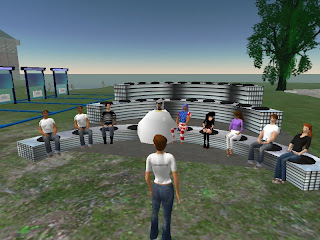Second Life has failed. More specifically, Linden Lab's promise of a virtual world, which will improve the human condition, has turned out to be false. And, astonishingly, it all boils down to the old
Immersionism vs Augmentationism debate. Who would have thought it?
There are two radically different groups of Second Life users. The first are the immersionists - escapists in disguise, who have come to Second Life to create a new life for themselves. They are lured here by the promise of a brave new world, a blank canvas on which they are free to draw their fantasies. From perfect bodies to Gor slave traders, from male to female (and sometimes, but rarely, from female to male), from autocracies to egalitarian communities, from translators to land barons - all are seeking something that is not available to them in the real world.
The other group are the augmentationists - drawn to Second Life by a promise of a world without boundaries, where geographical distance is meaningless and which can improve their existing lives - either personal, professional or both.
There is nothing wrong with either point of view - however, it is important to realize the difference in their expectations. The immersionists want, above all, a stable foundation upon which they can express their fantasies and desires. Not just platform stability - if you have to postpone your role playing for an hour because of disabled logins, that's annoying, but it is not the end of the world. No, they desire stability on the higher levels - a stable economy, laws, prices.
The augmentationists, on the other hand, value platform stability the most. They try to use Second Life as an aspect of their real life; they need a stable set of features with a roadmap of changes to follow, so they can migrate some of their activities from RL to SL. The in-world economy is less important to them, and so are the legislative changes.
Unfortunately, Linden Lab has miserably failed both these groups. Price and policy juggling, coupled with an inherent inability to feel and connect with their user base, have hurt the immersionists. A year of standing still, platform stability-wise and feature-set wise, have hurt the augmentationists. And all this combined has resulted in a failure to attract new users, which hurts both groups equally. How many new and interesting people did you meet in 2007 and how many in 2008?
I still believe that virtual worlds are a valuable tool for all - I just don't think that Second Life will be it. It will not be the Google of virtual worlds - I doubt it will even be Altavista. Perhaps Lycos or Webcrawler, to be mentioned in geeky old-skool debates in 2015.
So, what do we do while we wait for the *real* virtual word platform, which will be able to foster mass adoption?
I don't know about you - but I'm flying internet spaceships :)
EVE Online is a vast online game, spanning thousands of star systems and inhabited by a few hundred thousand players. It has an extremely complex system of production and trade - so much so that they employ an economist with a Ph.D. to oversee and tweak it (check out the
quarterly economic report); it fosters communities in the form of corporations and alliances that vie for territory and resources; the ship mechanics are mind boggling, to say the least, and you can never be truly safe.
I've played EVE Online since late July; in this time, I have seen one major new release and several patches which significantly improved user experience. One such example is Jita - a random system which has become the major trading hub, solely due to group dynamics. There are always around a thousand players in system and it was becomming increasingly lagged. CCP, the creators of EVE Online, have adapted to it by developing a
64-bit server code and deploying an extra-powerful server to power the node - and lag actualy disappeared.
Another example is a recent exploit which enabled some corporations to basically mint money
(*cough* copybot *cough*). When CCP heard of it, they
promptly responded, removed the assets and banned dozens of user accounts.
EVE Online even has a user government of sorts - the
Council of Stellar Management, elected twice a year by the EVE Online players, which periodically meet with CCP and represent the wishes and needs of the players.
Could this be any further from Linden Lab?
I am not leaving Second Life - I'll still be here, waiting with you for the real virtual world which will improve the human condition and where, I don't doubt, most of SL users will migrate in a heartbeat; but I'll spend more of my time elsewhere, where nobody knows my name and nameless strangers wait to blow me up - but where the creators, at least, care about my user experience.
Expect some stories about my EVE Online adventures soon :) and if you'd like to try it, IM me your email for a 21 day hassle-free invite code.















